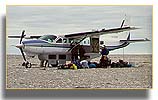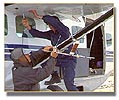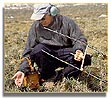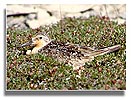|
|
|
The precise breeding areas of the Red Knots which use the Western Atlantic Flyway remains a mystery.
For the last two years, a team led by Dr. Larry Niles (New Jersey Division of Fish and Wildlife)
and Mark Peck (Royal Ontario Museum, Canada) has been searching northern Hudson Bay for breeding birds.
This spring, transmitters were attached to 65 Knots in Delaware Bay in the hope of tracking them once they reached the arctic.
This photo essay by Mark describes the expedition.
|
| We arrived on Southhampton Island, Northwest Territories, Canada on June 26, 1999 to search for nesting Red Knots. Our team comprised biologists and volunteers from the United States and Canada. Generous support from federal and state wildlife agencies and conservation groups had made our expedition possible. |
|
| Now we were ready to search for radio-transmitter birds. First, we would fly over the Island. Here is Larry and our pilot, Ed Swayda of Skyward Aviation, attaching an antenna to the wing strut to pick up signals from birds on the ground. |
| Once airborne, we donned headphones connected to a receiver and scanned for the specific frequencies which the transmitters on each bird produced. This is expedition member Sherry Meyer, NJ Division of Fish and Wildlife, taking her turn at listening. |
|
| We criss-crossed the Island in search of transmitter signals, flying along the raised ridges and beaches which dissect the island. These rather desolate areas are favoured by nesting knots, while other shorebird species on the Island prefer the wetter, more vegetated areas. |
| Luck was with us. We picked up signals. After mapping the approximate location of the signals, we put down to begin ground searches. Here are volunteer Nancy Donelly, Larry Niles, and Bruce Luebke, Cape May NWR, hiking in suitable habitat. |
|
| Ground searches initially turned up a transmitter but no bird! It had fallen off. Here is Larry Niles with the radio transmitter. The aerial and receiver are also visible. We were getting other signals still, so we kept searching. |
| Then, the big discovery! A Knot with a transmitter at a nest. It was sitting tight on four eggs. Finally, one small piece of the Red Knot breeding puzzle was in place. |
|
| Some judicious work and we had the bird safely trapped so that we could read its bands and check the transmitter. In all, 8 different transmitter signals were obtained over southern Southampton Island. Of these, seven transmitters were still attached to the birds and one had fallen off. | ||
|
| |||
Funding and support for the expedition was generously provided by:
|
| [ Home page ] | [ Maps ] | [ Data entry ] | [ Education ] | [ Contact Us ] |








